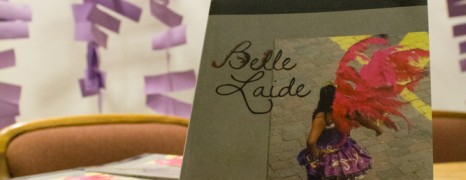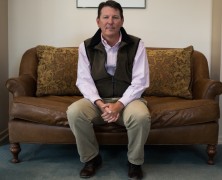SFUAD students answer the common icebreaker: “If you could have dinner with any person, who would it be?” and reveal what they would like to discuss with their picks. Answers range in variety from the predictable celebrity to an elusive family...
From São Paulo to Santa Fe
posted by Sandra Schonenstein
Sandra Schonenstein and Chris Stahelin continue with their profiles of international students. This week: Brazil. Both Thiago Ricco Dias (by Schonenstein) and Victor Rodrigues (by Stahelin) are from São Paulo, Brazil. Originally an advertising major, Dias is studying graphic design at SFUAD, and has sports photography in his mind for the future. Rodrigues f is a film major, who also does a bit of photography. He greeted Santa Fe saying, “Hi Santa Fe, my name is Victor and I love it here” in...
Soccer Unites
posted by Maria Costasnovo
“A child raised practicing sports is raised with values that nothing else can give them: companionship, solidarity and, most importantly, being able to be part of a team,” says Pablo Byrne, a senior from Mexico, and one of the students who meets every Tuesday at the Driscoll Fitness Center to play soccer. Last semester, a group of SFUAD students joined in the Boys and Girls Club of Santa Fe’s soccer league. Now, students—along with players from other schools and the Santa Fe community—transform the court at DFC to a multicultural meeting place each week. “One of the best things about soccer is the union it makes between people. We are from different countries. We are here, together, doing the same thing, at the same time and we all enjoy doing it, which is incredible,” says Victor Rodrigues from Brazil. And soccer, some players say, is the perfect sport to bring people together. “Sometimes, people in my country are really separated because of political reasons,” says Patrick Roessner of Mexico. “But when the World Cup comes, all of Mexico is united, supporting the same team and being happy or sad for the same reason: the victory or the defeat.” But even when people enjoy playing soccer, there are contrary opinions about this phenomenon called soccer: “When your team is playing, it seems like it is the only important thing in the world,” says César Pérez of Mexico, who enjoys the DFC game, but doesn’t have the same level of fanaticism for the game as a whole. “In my country, there are lots of problems in the politics, people being killed in the streets, and poverty. However, none of these things matter when it comes to soccer: people forget about these things and they are happy if...
The Surprises in Poetry
posted by Arianna Sullivan
“Please don’t be too polite,” said Joanne Dwyer, after reading the first of several poems from her first book, Belle Laide. “I want poetry readings to have a little more life in them. Be yourself… heckle me a little!” Before her reading began on Tuesday, Sept. 24 at SFUAD’s O’Shaughnessy Performance Space, Dwyer had admitted she was nervous, telling a friend that normally she spends “days and days and days not seeing anybody.” Once in front of the podium, however, she commanded the audience with a combination of humor, naked earnestness, and a reading voice that gave no sign of shaking. Dwyer straddles these sorts of dualities— internal shyness and outward composure—in her writing as well as her life. On one hand, she loves the fragmentation and collage of poetry, the way that “words and how we string them together are our tools as writers.” The rules in poetry are different, Dwyer says, so she feels free to let “imagination reign free to create image, sound and tonality without the normal everyday mundane rules of language.” At the same time, however, Dwyer admits that maybe the fragmentation and shorter form of poetry just matches her attention span better as a writer than fiction would. She loves reading fiction—making an effort to read Marquez’s One Hundred Years of Solitude annually—but says that, “the idea of writing a plot is just terrifying.” Her poetry, she explains, does not look for a truth in the way that a novel might. “Sometimes,” she says, “even I couldn’t tell you what the hell it’s about—that’s the magic of poetry, but sometimes I wonder if it’s to my detriment as a writer, if I’m just hiding behind the language.” Still, Dwyer is praised for her stream-of-consciousness and vocabulary-rich writing. She writes, says Creative Writing Co-chair Dana Levin, who taught Dwyer as a student at the College of Santa Fe, “in a way that tracks how the mind thinks. It is associative rather than linear.” Dwyer keeps this interesting by avidly reading up on everything historical, mystical and etymological that catches her attention and then working them into her poems. The mind, especially when its imagination is unfettered, is full of surprises. “The poetry that stays with me, that gives me an ecstatic juice,” says Dwyer, “is poetry that surprises me.” Dwyer both feeds and welcomes these surprises in her own writing by reading extensively, watching the world around her, and letting her own imagination string them together on the page. Dwyer, a 2005 graduate of CSF in creative writing and literature, does not lament how little time she has to write like many writers do. A mother of two, Dwyer’s says that being a mother made her a better writer, and visa versa. She recalls hearing a quote from Toni Morrison in which she says that she has written novels and won prizes, but really she neglected her son. “This really surprised me,” says Dwyer, “because I think that when there’s tension in your life, and you’re really living in the real world at the same time that you’re creating, you fight harder for that creative time.” When Dwyer began to feel that she’d spent enough time indulging in the reclusive act of reading and writing—for which she felt very lucky—she became involved in the Brooklyn-based Alzheimer’s Poetry project. “It just seemed like time to give something back,” she says. She would read poetry out loud to dementia patients in nursing homes, many of whom were losing their mental capacity for language. Dwyer found this process rewarding on many levels, and still makes regular visits to nursing homes around New Mexico. “Some of them had to memorize poems when they were young,” she exclaims, “and they remember them when I start to read. The whole thing becomes a sort of call and answer.” The return to dignity—let alone language—that she sees in the elderly, who...
Q/A w Larry Hinz
posted by Arianna Sullivan
Larry Hinz, president of the Santa Fe University of Art and Design, has seen the school go through major changes since 2009. Here he answers some questions about how the school is growing, his vision for the future, and what it is that makes SFUAD special. *The following interview has been edited for conciseness. JM: How do you think SFUAD has changed since you began as president? LH: We’ve had an incredible 3 1/2 to four years of transition. We’re at an exciting place in time for this school. We have over 800 students, and the campus seems more alive—I walk across campus and I see students, so it’s really good for me to have that contrast to what it was like four years ago when we were trying to save the school. The student body is the most talented that I’ve seen since I’ve been here; it’s an engaged, energetic dynamic group of students that we have here and the faculty are really jazzed about that. I also think the campus looks really good; the quad is more welcoming than it was two years ago, for example. We will continue to make improvements to the campus and the buildings as time goes on. Also, we do a satisfaction survey every April, and student satisfaction is way up. There are common themes: students love the faculty, love the classroom, love the courses, love the facilities. Some of the negatives continue as well, like the cafeteria and the dorms and student activities, but this year has been a huge improvement overall. Another area that we track closely is student retention rates. That has also shown consistent improvement over the last year. I think this goes back to that engaged student body. Overall, the group of kids that are...






 Jackalope Magazine is the student magazine of Santa Fe University of Art and Design. Building on the interdisciplinary nature of our education, we aim to showcase the talent of our university and character of our city.
Jackalope Magazine is the student magazine of Santa Fe University of Art and Design. Building on the interdisciplinary nature of our education, we aim to showcase the talent of our university and character of our city.
Recent Comments